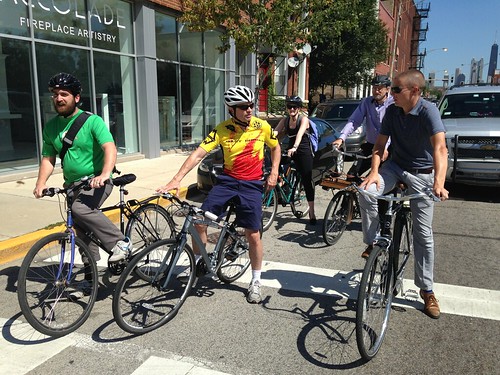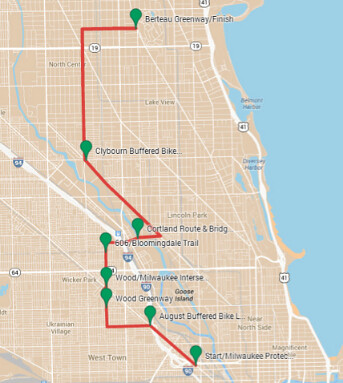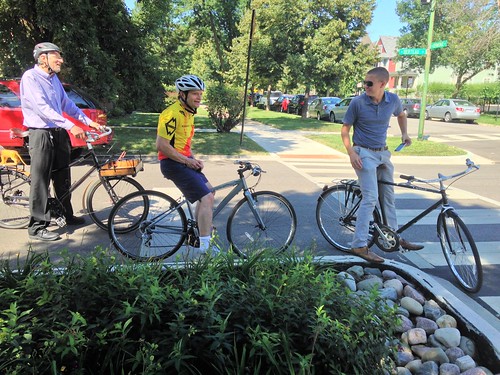
Yesterday, Congressman Mike Quigley (IL-05) took a spin on some of our city’s next-generation bikeways with a city staffer and local advocates, as part of his “Mike on the Move” campaign to highlight how federal funding can support Chicago transportation infrastructure.
Quigley's district covers a large swath of Chicago’s North Side and a few inner-ring suburbs. He's the only Illinois rep currently serving on the House Appropriations Committee, where he’s a member of the transportation subcommittee.
The congressman helped win a $35 million Core Capacity grant for the CTA’s Red and Purple Modernization project, and he pushed for increased funding for the Transportation Investment Generating Economic Recovery grant program, which has bankrolled transit, bike, and pedestrian improvements.
Recently, Quigley successfully included language in the transportation subcommittee's 2015 report calling on the Federal Highway Administration to create new safety performance measures for bicycle and pedestrian traffic. These would be used by states to track and reduce injuries and fatalities. He also fought against changes to legislation that would have blocked funding for transit, bike, and pedestrian projects.
Last month, Quigley kicked off his infrastructure campaign with a tour of Red, Purple and Brown Line infrastructure. Future excursions will highlight Metra, Chicago’s freight network, the Pace bus system, Divvy bike-share, and the Bloomingdale Trail.
Mike Amsden from the Chicago Department of Transportation led yesterday’s tour of North Side bike facilities, and the Active Transportation Alliance’s Jim Merrell and Randy Neufeld from the SRAM Cycling Fund came along for the ride. Starting at Milwaukee and Green in River North, Amsden showed Quigley the protected and buffered bike lanes that CDOT installed last year on Milwaukee. From there, they checked out new buffered lanes on Augusta, then headed north on the recently built neighborhood greenway on Wood.
After that, they rolled east on Cortland, where Quigley noticed the non-slip bridge plates on the bridge over the Chicago River. From there, they headed northwest on Clybourn, which is slated to become the first state-jurisdiction road in Illinois with protected lanes. Next they pedaled north on Damen to the Berteau Greenway, where Amsden showed the congressman how traffic calming and a contraflow lane transformed the street into a mellow, two-way bike route.
Before he got in the saddle, I asked Quigley a few questions about his crusade for better transportation infrastructure funding, as well as his biking habits.
John Greenfield: How did you get the idea for the Mike on the Move campaign?
Mike Quigley: What made me think of it was, during the last appropriations cycle on the transportation subcommittee, my colleagues across the aisle said, “We’re short on money, so we don’t want to use any money for bikes, or for public transportation. And that’s just so backwards. It’s the antithesis of where the whole world is going. Miles ridden on bike [and walked by] pedestrians are going up, and vehicle miles traveled in cars are going down. So we gotta rebuild our country with a new mindset about how people currently get around and, more importantly, how they really need to get around.
JG: [The federal transportation funding bill] MAP-21 expires in May, and it looks like we might have Republican control of both houses by then…
MQ: You’re cheering me up today!
JG: If that happens, what kind of transportation bill do you think we might expect from a Republican majority?
MQ: It’s not just that they’re not necessarily looking at a new generation and a new way of getting around. So I think what you’d expect is a bill that’s car-centric, and not enough funding. Even if you’re just focusing on cars, there’s still enough to worry about. We have 100,000 bridges in this country that qualify for Medicare – that’s how old they are.
The way transportation is operated in this country is firmly entrenched in 60 or 70 years ago. Some politicians haven’t caught up to how the world is transforming. They still believe that if you make a street wider you’re going to solve traffic problems.
It’s like what the Cook County Forest Preserve did when I was [a county commissioner] -- they chopped down trees to widen a county road so people could drive more cars. Here we are, cutting down the things that are actually absorbing carbon dioxide, to put things out there that create more. And induced demand says that if you build it, they will come. So you’re not actually reducing the congestion, because if people think, “Oh, you can get through here,” more people will drive.
You don’t want to encourage more people to get in a car. You want to encourage them to get around on Metra, the CTA, their bike, or by walking.
JG: What revenue options do you support for increasing funding for transportation infrastructure? Do you think it might be appropriate to do an increased gas tax, or a fee based on vehicle miles traveled?
MQ: I favor the gas tax. Obviously, VMT are going down. But I still favor it, and the truckers favor it, because they know we gotta build the infrastructure. But I’m open to any sources of revenue, because this gives back so much. And the jobs that infrastructure improvements create pay for themselves. Even in an economic downturn, let’s just remember what FDR did in the middle of the greatest depression in our country’s history. He built infrastructure. We need to do the same, but infrastructure for the next, new world, which is active.
JG: Have you been getting much biking in this summer?
MQ: In Chicago, maybe 90 percent of my trips are by bike, and I’ve gone on a few Kidical Mass rides – that’s a great way to get families and kids out on bikes. In D.C., the only trips I do by car are to and from the airport. As a side note, I ride my bike to the White House, and the last three times, they made me walk away from my bike and had a dog sniff it. I wanted to take a picture, but I didn’t want to embarrass the dog. He looked positively sheepish. But it just tells you: not enough people ride their bikes.






